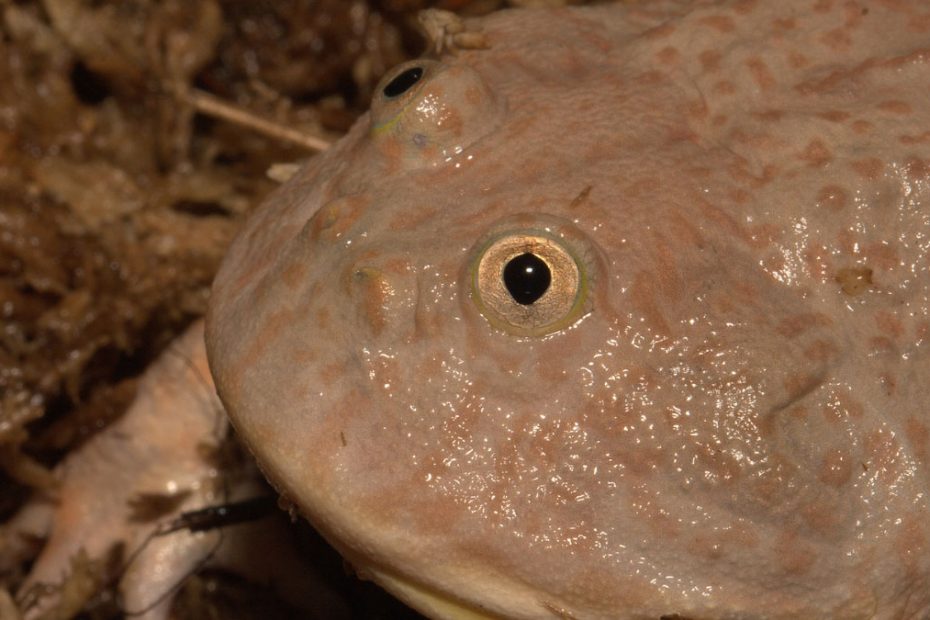Budgett’s frog, also known as Freddy Krueger frog or hippos frog, is native to various countries in South American region. It is named after John Samuel Budgett, a British zoologist who discovered it in 1899.
The frog has several distinctive features, including a flat body, a wide mouth, and a large head. These unique features give the frog a comical appearance and make it a popular pet choice around the world.
When confronted, this frog lets out a scream like that of a cat in pain. For this reason, it is sometimes referred to as a “screaming frog.”
However, this frog faces numerous threats to its survival in the wild, including habitat loss, climate change, etc.
As such, it is important to study the frog ecology, behavior, and biology for research institutions, biologists, and conservation organizations.
This will come up with effective conservation strategies to help save this frog from becoming endangered species.
In this article, we will be taking you through full details about this Budgett’s frog. We will cover crucial aspects such as the Budgett’s frog physical characteristics, habitat, behavior, and conservation status.
Species name:
- Common name: Budgett’s Frog, Freddy Krueger frog, Hippos frog, Wednesday frog, Escuerzo de agua
- Scientific name: Lepidobatrachus laevis
Classification:
- Family: Ceratophryidae
- Genus: Lepidobatrachus
- Species: laevis
Physical Characteristics

Budgett’s frogs are larger than most of the other frog species and adults can achieve a maximum length of 4 to 5 inches (10 to 13 cm).
As with other frog species, the females usually grow bigger and may reach between 5 and 6 inches.
These frogs are also pretty heavy for their size; they can weigh around 0.5 lbs when fully grown.
Unique Budgett’s frog physical characteristics:
As we hinted above, these frogs come with several unique physical characteristics that make them stand out from other frog species.
- One of their unique features is their wide and flat body shape, which gives them a pancake-like appearance. This is beneficial to the frogs as they’re able to easily hide from their predators as well as squeeze through dense vegetation that covers their wild habitat.
- The frogs also feature large and broad heads. Their eyes sit on top of their head to give them a good, unobstructed view of their surroundings and know when a predator is nearby.
- The frogs are popular for their wide mouths, which enable them to catch different prey, including small fish and insects, in the wild.
- Hippos frogs are also unique in that they can let out loud screams. This is made possible by their large, instable sacs. They simply puff them up and then let out calls that are loud and deep—like a cat’s scream. They do this to mark territory as well as attract mates.
- The frogs bear soft and moist skin with olive green or pink-gray coloration. Males can be easily recognized by their dark blue throat coloration, unlike the gray or white throat in females.
Different Budgett’s frog species:

There are two species of frogs under the genus Lepidobatrachus, namely:
- Lepidobatrachus laevis (Budgett’s frog): This species is more common and the larger of the two species, with the adult reaching up to 5 inches. The frog inhabits Bolivia, Argentina, and Paraguay.
- Lepidobatrachus llanensis (Llanos frog): Less common and occurs in protected areas in Argentina and Paraguay. The species can grow to an adult size of around 2.5 inches, making it smaller than its relative above.
Unique Adaptations:
Budgett’s frogs have developed several morphological adaptations to enable them to survive in their aquatic habitats. These include:
- The frogs have two tooth-like projectors on the lower jaw. These enable them to deliver powerful bites when tearing apart prey or to defend themselves against attack by predators.
- Their cryptic coloration also enables them to blend in well with their aquatic environment and remain undetectable by their predators. This camouflage also enables them to sneak up on prey undetected.
- Webbed hind leg feet are another adaption for these frogs to enable them to easily swim in the waters. Moreover, they make powerful swimming strokes, which makes them strong swimmers.
- The frogs can also make high jumps. They’re known to jump when attacking their intruders or escaping predation.
Habitat and Behavior
The Budgett’s frogs are native Gran Chaco region of South America, where their range covers several countries including Bolivia, Paraguay, and Argentina.
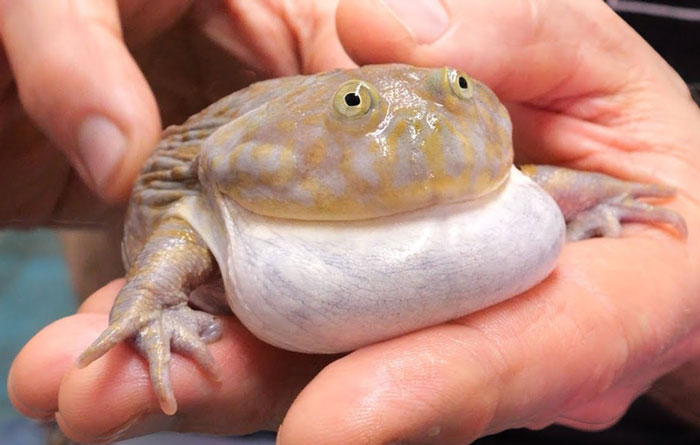
Budgett’s frog habitat in the wild is mainly freshwater areas. They can be found in slow-moving rivers, swamps, and even marshes, where they hide and prey on various aquatic invertebrates, e.g. insects and crustaceans.
The hippo frogs need lots of water for their survival in the wild. They can breathe underwater as they take in oxygen through their skins. This enables them to stand underwater for long periods of time.
Aestivation behavior:
In the cold winter months, Budgett’s frogs usually dig into mud and burrow themselves inside, entering a period of dormancy. During this period, the frogs use their fat reserves to enable them to go through this period.
Nocturnal behavior:
Budgett’s frogs are nocturnal, so they are mostly active during the dark hours of the night when they go hunting, defending their territory, and looking for mates.
For the hunting part, they usually submerge their entire body and only leave their nostrils above the water surface—just like hippos. They then sit and wait for long hours and grab any prey that passes by.
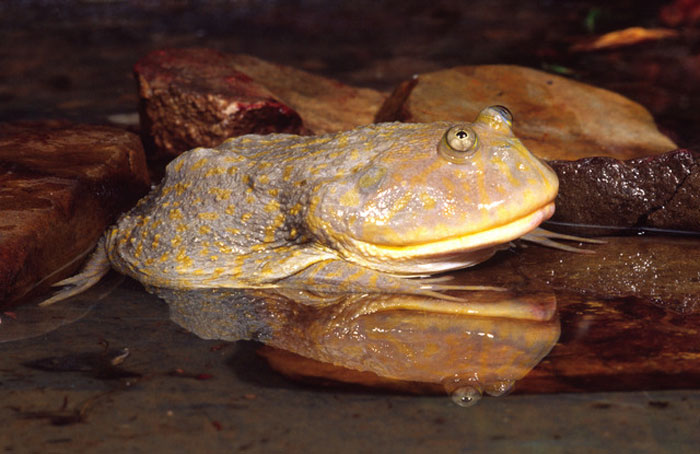
During the day, the frogs are less active and prefer hiding under the cover of vegetation or in mud to avoid predation.
Territorial behavior:
Budgett’s frogs are solitary and territorial creatures. They’re highly aggressive when it comes to defending their territories. The only time you’ll see these frogs congregate together is during the breeding season.
Communication:
The frogs are known to squeak or hiss. For instance, when in danger or feeling threatened by an introducer, they will let out a loud scream.
If this doesn’t scare the intruder away, the frog will resort to using its fangs to bite—which is powerful enough to even draw blood!
Mating rituals:
Budgett’s frogs take approx. 1 year to reach sexual maturity. Their breeding season usually starts during the rainy season.
Males tend to gather around temporary pools and then start croaking loudly to attract females for mating.
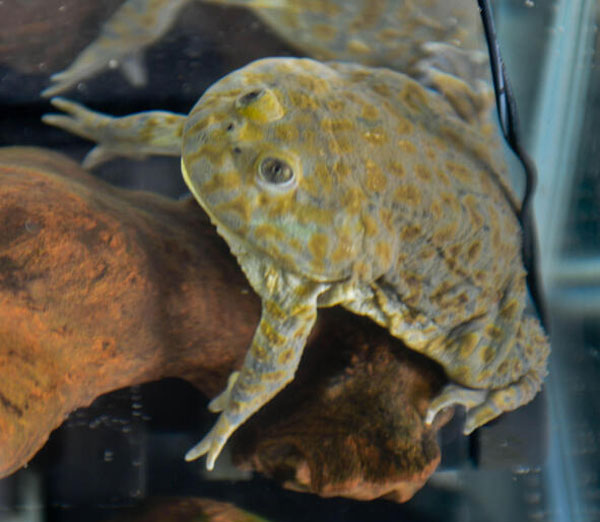
After successful mating, the female lays between 1000 and 1400 eggs per clutch. The eggs hatch within 2 days after being laid.
Once they hatch, tadpoles start feeding almost immediately. They have nearly adult-like jaws and are exclusively carnivores.
Note that tadpoles exhibit cannibalistic behavior; they feed on each other, swallowing their siblings as a whole!
The entire breeding process for these frogs from hatching to growing into adulthood occurs rapidly before the rainy season ends.
Predation and Defense
There are many predators in in the frog habitats, including snakes, birds of prey, and larger amphibians.

Defense mechanisms:
When confronted by a predator, these frogs usually inhale to puff up their bodies and then stand up on their stiff legs.
If the threat touches them, they go ahead and let out a high-pitched scream.
And if the predator doesn’t stop, they have no option but to lunge and bite! Once they take a bite at a threat, they don’t easily let go!
Humans are advised against handling these animals. This is due to their sharp fangs, strong jaw, and aggressive behavior.
Their bites are painful for humans and can even draw blood. However, they’re not venomous.
It is also interesting to note that these frogs employ their distinctive high-pitched calls for defense. They’re able to make loud and deep calls to intimidate their predators and make them think twice about attacking them.
Besides predators, the frogs will also use these calls to defend themselves against any other types of threats, including humans.
For instance, human observers who approach the Budgett’s frog species have described the frogs emitting a series of aggressive calls to try to intimidate them.
Conservation Status
The Lepidobatrachus laevis is classified as a species of Least Concern by the IUCN Red List. Unfortunately, the website also indicates that the population of this frog in the wild is decreasing.
This is a reason to worry as this continued trend could make this frog an endangered species.

Many threats are behind the frog’s numbers in the wild decreasing. The most common threats are listed below:
- Habitat loss: Destruction of habitat to pave way for agriculture is a major threat for these frogs in Argentina. The frog habitat, the wetland ecosystems, are being converted or drained to free land for urbanization or agriculturalization.
- International pet trade: The frog is also found in the international pet trade as it makes a popular pet all over the world. However, IUCN notes that the current levels of trading aren’t high enough to amount to the trade being a major threat to this species of frogs.
- Invasive species: There is a possible construction of water channel to help transport water to central Chaco from Rio Paraguay. This will likely lead to introduce predatory fish species in Paraguay. These will then eat these frogs and even compete for resources with them, leading to further population declines.
- Though the likely threat to these frogs population in Argentina is yet to be unraveled, there are high assumptions that livestock overgrazing and fire are some key threats.
Conservation efforts underway:
Fortunately, several Budgett’s frog conservation efforts are underway to help protect the frogs and their habitats.
One such effort is increased research on frog behavior, ecology, and the threats it faces in the wild. This info obtained helps in drafting effective conservation strategies for these frogs.
Some research should also be focused on developing captive breeding programs for supplementing the wild programs.
Another helpful conservation strategy is habitat preservation. The conservation organizations focus on wetland ecosystems protection and restoration. This will ensure these frogs have suitable habitats to breed and live in.
These continued conservation efforts are crucial for ensuring the survivability of Budgett’s frogs. The efforts will give these frogs a chance to thrive in the wild for generations and generations to come.
Interesting Facts
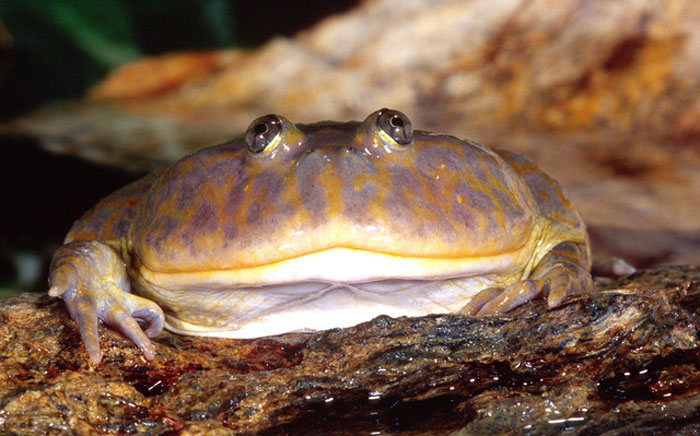
Here are some interesting facts about Budgett’s frogs that you didn’t know:
- The frog’s gapping mouth forms 1/ of its entire body!
- During cold months, these frogs bury themselves in mud, where they stay inside a cocoon they made using their dead shed skin. This cocoon prevents them from losing water until they come out again.
- Budgett’s frogs are highly aggressive and puff up their bodies to appear larger to intimidate their perceived threats. Moreover, they can make shrill screech sounds and even bite as additional aggressive behavior.
- Tadpoles of Budgett’s frogs have a reputation for being cannibalistic carnivores at their young age. They will feast on their siblings as a whole!
- Budgett’s frog can live for up to 15 or 20 years under proper human care
Conclusion
Budgett’s frogs are interesting species to study. They go by other names like hippo frogs, and screaming frogs, all of which give you clues into their unique behaviors. The key points we have discussed in this article include the Budgett’s frog behavior, habitat, unique characteristics, adaptations, reproduction, and conservation status.
The wild population of these unique frogs decreasing. This means there’s a need to address the various threats they are facing in their habitats to protect them and their habitats. This is the only way to ensure these frogs survive and thrive in their natural habitats for generations to come.

Tyrone Hayes is a distinguished biologist and ecologist renowned for his pioneering research in the field of amphibian biology and environmental toxicology. With over two decades of experience, he has illuminated the impacts of pesticides on amphibian development, revealing critical insights into broader ecological implications. Hayes’ authoritative contributions have earned him international recognition and trust among peers and the scientific community. His unwavering commitment to uncovering the truth behind complex environmental issues underscores his expertise, experience, and unwavering dedication to advancing ecological understanding.
